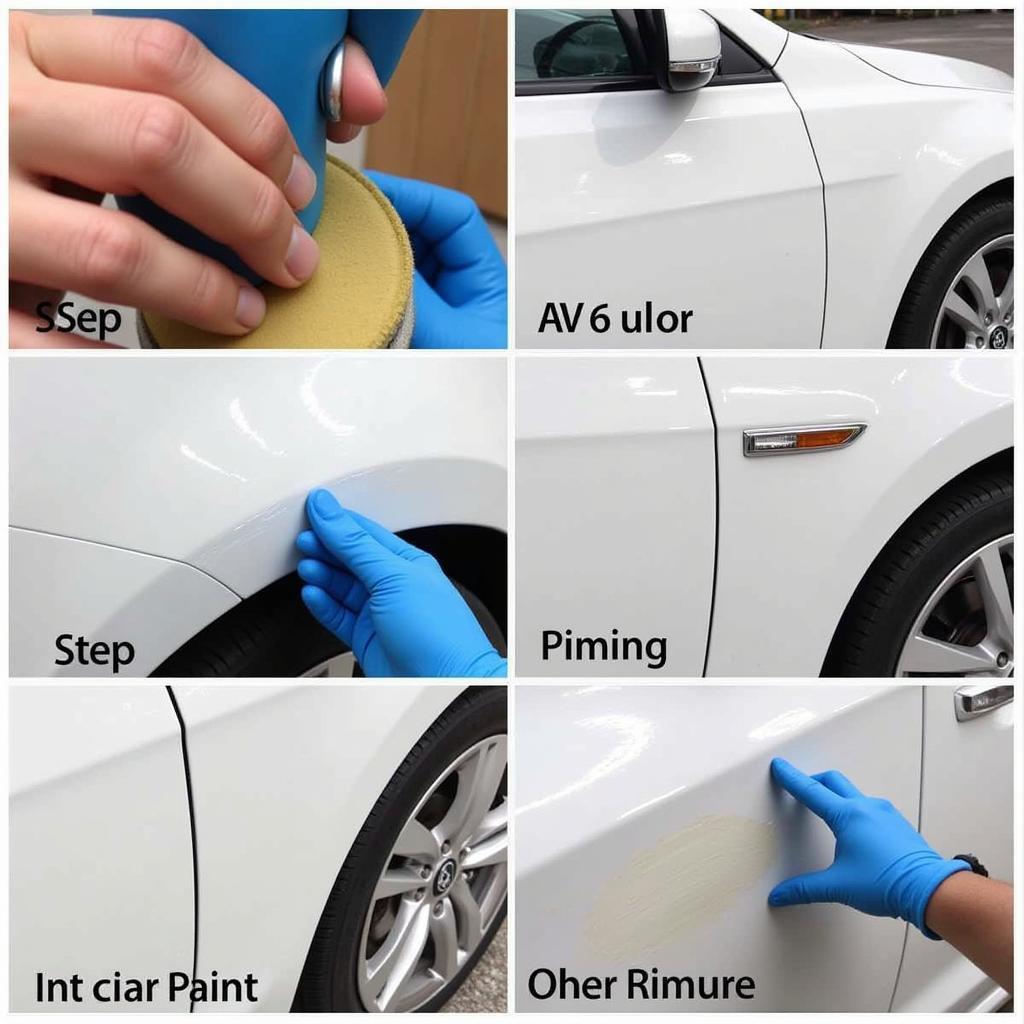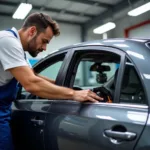Car body repairs and resprays are essential services for maintaining a vehicle’s appearance and structural integrity. Whether it’s a minor scratch, a significant dent, or a complete color change, understanding the process and choosing the right repair shop is crucial. This guide will delve into everything you need to know about car body repairs and resprays, from assessing the damage to finding a reputable repair facility.
Understanding Car Body Repairs
Car body repair encompasses a wide range of services designed to restore a vehicle’s exterior to its pre-accident condition or enhance its aesthetics. These repairs can range from minor touch-ups to major overhauls, depending on the extent of the damage.
Types of Car Body Damage
Common types of car body damage include dents, scratches, scrapes, rust, and cracks. Dents can occur from minor impacts, such as shopping carts or hail, while scratches and scrapes can result from collisions with objects or other vehicles. Rust is a more serious issue that can compromise the structural integrity of the car body, requiring more extensive repairs. Cracks, often caused by significant impacts, demand immediate attention to prevent further damage.
If you’re looking for reliable car body repair services in specific locations, consider checking out options like car body repair in the wolds. These specialized shops often offer expertise tailored to local needs and conditions.
Assessing the severity of the damage is the first step in determining the appropriate repair method. Minor scratches might only require a simple touch-up, while deeper damage might necessitate panel replacement or extensive bodywork.
Car Body Repair Techniques
Modern car body repair utilizes advanced techniques and tools to ensure a seamless and durable finish. These techniques include:
- Paintless Dent Repair (PDR): This technique is used for minor dents where the paint hasn’t been damaged. Specialized tools are used to massage the dent from the inside out, restoring the panel to its original shape without the need for repainting.
- Body Filler: For more significant dents, body filler is used to fill in the damaged area. The filler is then sanded down and smoothed to create a seamless surface for painting.
- Panel Replacement: In cases of severe damage, the entire panel might need to be replaced. This involves cutting out the damaged section and welding in a new panel.
Car Resprays: A Fresh Coat for Your Vehicle
Car resprays involve applying a new coat of paint to the entire vehicle or specific sections. This can be done for cosmetic reasons, such as changing the car’s color, or to repair damage to the existing paintwork.
Types of Car Paint
Several types of car paint are available, each with its own advantages and disadvantages:
- Acrylic Lacquer: This is a traditional type of paint that offers a high-gloss finish. However, it is less durable than other options and can be prone to chipping and fading.
- Acrylic Enamel: This type of paint is more durable than acrylic lacquer and offers good resistance to chipping and fading.
- Urethane: Urethane paints are highly durable and offer excellent resistance to chemicals and UV rays. They are also more expensive than other options.
For those seeking car body repair services in specific areas, resources like car body repair shop maidstone can provide valuable information on local shops specializing in these services.
The Respray Process
The respray process involves several steps:
- Surface Preparation: The car’s surface is thoroughly cleaned and sanded to remove any imperfections and create a smooth surface for the new paint to adhere to.
- Priming: A primer is applied to provide a base for the paint and promote adhesion.
- Painting: The new paint is applied in multiple thin coats to ensure even coverage.
- Clear Coat: A clear coat is applied to protect the paint and provide a glossy finish.
Choosing the right car body repair shop is crucial for ensuring a high-quality repair and respray. Look for shops that are certified, experienced, and use high-quality materials. You might find it helpful to search for specific services in your area, like car body repairs springvale, to identify reputable options.
Choosing the Right Car Body Repair Shop
When choosing a car body repair shop, consider the following factors:
- Reputation: Look for shops with a good reputation in the community. Check online reviews and ask for recommendations from friends and family. Specialized services, such as those offered at belper car body repairs, can often provide a more focused expertise for specific repair needs.
- Experience: Choose a shop with experienced technicians who are trained in the latest repair techniques.
- Equipment: Ensure the shop uses high-quality equipment and materials.
- Warranty: Check if the shop offers a warranty on their work.
Conclusion
Car body repairs and resprays are essential for maintaining your vehicle’s appearance and value. By understanding the process and choosing the right repair shop, you can ensure a high-quality and long-lasting result. Whether it’s a minor scratch or a major overhaul, addressing car body repairs and resprays promptly helps preserve the integrity and aesthetics of your vehicle. Don’t hesitate to research options like car body repairs bridgend industrial estate for more localized services.
FAQ
-
How long does a car respray take? A car respray typically takes a few days to a week, depending on the extent of the work.
-
How much does a car body repair cost? The cost of car body repair varies depending on the extent of the damage and the type of repair required.
-
Can I respray my car a different color? Yes, you can respray your car a different color.
-
How do I choose the right paint color for my car? Consult a professional paint shop for advice on choosing the right paint color.
-
What is the best way to protect my car’s paint? Regular washing and waxing can help protect your car’s paint.
-
How often should I get my car resprayed? A car respray is typically needed every few years, depending on the condition of the paint.
-
What is the difference between a full respray and a partial respray? A full respray involves painting the entire car, while a partial respray only covers specific sections.
For further assistance, please contact us via WhatsApp: +1(641)206-8880 or Email: [email protected]. Our customer service team is available 24/7.


